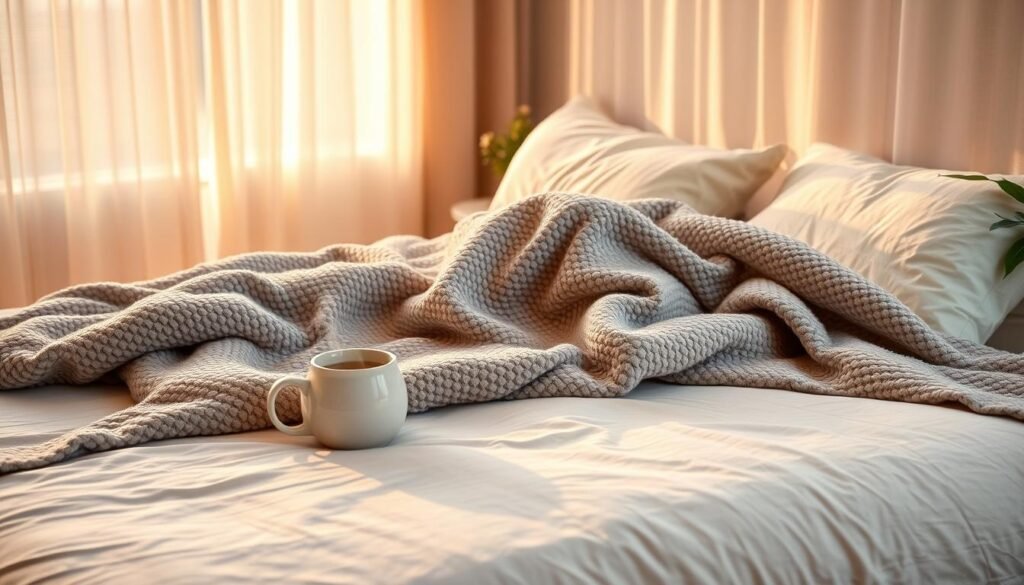Did you know nearly 31% of adults in the U.S. have an anxiety disorder at some time? This big number shows how common anxiety is, often seen through anxiety chills. These chills, a reaction to anxiety, greatly affect people’s lives and happiness. As we learn more about mental health, many look for natural ways to ease anxiety without medicines.
In this article, we’ll go over different self-care ways to lessen anxiety chills’ discomfort. You’ll find out about how the body reacts to anxiety and ways to feel better, including yoga and essential oils. These have helped many. To learn more and find other resources to handle anxiety, visit this website. Your path to feeling more calm and stable begins now.
Key Takeaways
- Nearly 31% of American adults experience anxiety disorders, highlighting the need for effective relief strategies.
- Anxiety chills can be a physical manifestation of anxiety that impacts daily life.
- Natural remedies, such as herbal supplements and mindfulness practices, can help alleviate anxiety.
- Understanding the physiological basis of anxiety can enhance the effectiveness of relief methods.
- Regular exercise has been shown to provide significant short-term relief from anxiety symptoms.
- Consulting a healthcare provider is important before starting any new treatment or supplement.
Understanding Anxiety Chills
Anxiety chills can unsettle many. These feelings pop up when the body’s fight-or-flight mode kicks in. Understanding anxiety chills means knowing the symptoms and triggers. Knowing the causes helps people manage their experiences and find coping methods.
What Causes Anxiety Chills?
Anxiety chills have many causes. Stress or anxiety can mess with how your body controls temperature. This can make you feel cold and shaky. Sometimes, emotional distress or panic attacks enhance these feelings. A heightened state of arousal might cause sudden chills or trembling, preparing the body to face threats.
Common Symptoms Associated with Anxiety Chills
Common symptoms of anxiety chills are:
- Shaking or trembling
- Muscle tension
- Numbness or tingling sensations
- Alternating chills and hot flashes
- Rapid heartbeat
- Dizziness
- Digestive issues
It’s important to recognize these symptoms for those experiencing anxiety chills. Knowing how the body reacts helps individuals use coping strategies against these uneasy feelings.
The Physiological Response to Anxiety
Anxiety sets off different bodily reactions, which lead to feelings like chills. By understanding how our bodies respond to stress, we can get insights into these reactions. One key aspect is the fight or flight response, alongside the role of hyperventilation.
The Fight or Flight Response
This response is how our bodies get ready to face or escape danger. It sends a wave of adrenaline throughout our system. This reaction narrows the blood vessels, limiting blood to our hands and feet. So, we might feel cold or even get chills.
When we’re anxious, our body and hormones change, leading to various physical signs. These signs are all part of the body’s response to stress.
How Hyperventilation Influences Anxiety Chills
Hyperventilation often happens without us realizing it, especially when we’re anxious. It makes us breathe quick and shallow. This drops carbon dioxide levels in our blood.
Low carbon dioxide makes our blood vessels narrow, and it changes the acidity in our blood. This can make us feel colder and can heighten anxiety, making the chills worse.
Natural Remedies for Anxiety
Many people look into natural remedies for anxiety to find relief. Exercise and herbal supplements are popular for their mental health benefits. They can make you feel better and reduce anxiety when used regularly.
The Role of Exercise in Reducing Anxiety
Regular physical activity is great for the mind. It releases endorphins, which are natural mood lifters. Exercise can also increase your sense of achievement and improve self-esteem. People who work out often tend to feel less anxious and stressed. Simple activities like walking, dancing, or yoga can help make exercise a part of your life.
Herbal Remedies and Their Efficacy
Herbal remedies, like chamomile, are gaining popularity for anxiety relief. Chamomile, especially, has shown promise in reducing anxiety symptoms. It may affect brain chemicals that regulate anxiety. Lavender and valerian root are also effective for their calming effects. But, it’s essential to consult with a healthcare provider before trying these remedies. For more information on natural anxiety management, check out resources on CBD usage.
Mindfulness and Meditation Techniques
Adding mindfulness and meditation to your daily life can help ease anxiety. It makes for a peaceful setting that lets you stay in the now. This has many pluses. Knowing the good it brings helps us use it to calm our worries.
Benefits of Practicing Mindfulness
Mindfulness is more than just relaxing. It’s a key way to handle feelings, lessen stress, and get healthier. Using mindfulness sharpens your mind and steadies your emotions. This helps deal with anxiety’s ups and downs. By doing it often, you can:
- Lower stress and anxiety
- Boost your focus and ability to pay attention
- Grow your emotional strength
- Improve how you feel overall
Effective Meditation Strategies
Meditation offers a great way to ease anxiety. Focusing on your breathing, doing body scans, and picturing calm scenes are good choices. Here are some top meditation methods to try:
| Meditation Technique | Description | Benefits |
|---|---|---|
| Breath Awareness | Concentrating on breathing in and out. | Makes you relaxed and clear-headed. |
| Guided Visualization | Thinking of peaceful, soothing places. | Boosts how you feel inside. |
| Body Scan | Thinking about each body part in turn. | Eases stiffness and makes you more mindful. |
Making these meditation types part of your day can do wonders. They relax you, cut down on anxiety, and give many mindfulness benefits. Trying these methods can help you handle stress. It leads to a real sense of peace and well-being.

Breathing and Relaxation Techniques
Anxiety can be managed with different strategies. Of these, breathing techniques are key. They help normalize breathing and ease anxiety. Deep breathing and progressive muscle relaxation are great for helping with anxiety.
Deep Breathing Exercises
Deep breathing uses the diaphragm to increase oxygen intake. This lowers stress. It involves taking slow breaths in through the nose and out through the mouth. You inhale for four counts, hold for four, then exhale for six. This helps calm the body’s response to anxiety.
Progressive Muscle Relaxation
Progressive muscle relaxation works by tensing and releasing muscles. It helps identify and lessen physical tension linked to anxiety. By paying attention to tension and relaxation, you become more aware of stress. With regular practice, it leads to deeper relaxation and is effective for anxiety relief.
Warmth and Comfort Measures
Dealing with anxiety chills highlights the importance of staying warm. Warmth increases a sense of safety, helping manage symptoms better. Comfort measures like these do more than ease anxiety. They create a calming environment.
The Impact of Keeping Warm on Anxiety Chills
To reduce anxiety chills, keeping warm is key. Cold can make discomfort worse, raising anxiety levels. By staying warm through layered clothes, heated blankets, or warm drinks, individuals can keep calm. The physical warmth reassures and helps the body cope during stress.
Using Weighted Blankets for Anxiety Relief
Weighted blankets are now popular comfort measures for easing anxiety. They give deep pressure, like a hug, which calms the mind. Studies show they lower anxiety, boost sleep quality, and manage symptoms. Offering security, they make individuals feel secure and relaxed.

| Comfort Measure | Benefits |
|---|---|
| Heated Blankets | Promotes relaxation and warmth, reducing chills |
| Layered Clothing | Easy to adjust for personal comfort levels |
| Weighted Blankets | Offers deep pressure stimulation for anxiety relief |
| Warm Beverages | Provides internal warmth and comfort |
Edibles for Anxiety: A Natural Alternative
Many are turning to natural solutions to ease anxiety, and edibles offer an intriguing choice. With components like CBD and THC, these edibles are famed for their calming impact. They come in various types, catering to different tastes, especially for those preferring not to smoke or vape.
Types of Edibles for Anxiety Relief
Cannabis-infused treats are available in many forms, such as:
- Gummies
- Chocolate bars
- Baked goods
- Tinctures
These edibles offer a discreet, pleasant way to use cannabis for anxiety management. Beginners should start with a small dose to see how they react. It’s important to choose the right type of edible based on individual needs.
Understanding CBD and THC Edibles
CBD edibles draw interest for their health benefits without causing a high. They’re especially good for anxiety because they don’t have the strong effects of THC. Studies suggest small amounts of THC can help, but too much might worsen anxiety feelings.
Edibles made from Indica strains are chosen often for their calming effect. Remember, it can take up to two hours to feel their full effect. So, patience is key. Always talk to a health expert before trying edibles, especially if you have severe anxiety or other health issues.
Therapeutic Options for Managing Anxiety
Many people with anxiety find relief by exploring different therapy options. Therapy offers support to manage anxiety symptoms effectively. It gives people tools to overcome challenges and builds emotional strength.
The Importance of Therapy and Counseling
For those dealing with anxiety, therapy is crucial. It provides a safe place for sharing thoughts and emotions freely. Techniques like cognitive behavioral therapy help identify and change unhealthy thoughts. This leads to better mental health and highlights the value of therapy for anxiety relief.
Understanding Cognitive Behavioral Therapy (CBT)
CBT is a top choice for managing anxiety. It targets negative thoughts and actions that fuel anxiety, to promote healthier thinking. Clients learn to face their fears and correct false beliefs. Many report greater control over their emotions after CBT, showing its deep impact.

| Therapeutic Options | Description | Main Techniques |
|---|---|---|
| Cognitive Behavioral Therapy (CBT) | A structured approach to identify and change negative thought patterns. | Thought records, exposure therapy, cognitive restructuring |
| Humanistic Therapy | Focuses on personal growth and self-actualization. | Client-centered therapy, empathetic listening |
| Mindfulness-Based Therapy | Incorporates mindfulness practices to reduce anxiety and increase awareness. | Mindfulness meditation, breathing exercises |
When to Seek Professional Help
Knowing when you need more help for anxiety is key to your well-being. Some signs clearly show it’s time to get professional help. Recognizing these signs early means you can get the support you need sooner.
Signs That Indicate the Need for Professional Assistance
- Chronic anxiety that persists despite self-care techniques.
- Severe physical symptoms, including increased heart rate or panic attacks.
- Thoughts of self-harm or feelings of hopelessness.
- Anxiety that interferes with daily life, such as work or personal relationships.
- Inability to manage anxiety despite efforts and support from friends and family.
- Escalating feelings of distress or overwhelming fear in social situations.
When you notice these signs of needing assistance, it’s important to act quickly. Looking into treatment options like medication or counseling can really help. Taking these steps can greatly improve your life.
| Sign of Needing Assistance | Description |
|---|---|
| Chronic Anxiety | Ongoing anxiety that does not fade over time. |
| Physical Symptoms | Severe physical reactions, such as panic attacks. |
| Self-Harm Thoughts | Dangerous thoughts that require immediate professional help. |
| Interference with Life | Anxiety impacts daily activities and social interactions. |
| Feeling Overwhelmed | A sense of distress that is difficult to manage alone. |
Conclusion
In summary, managing anxiety naturally can make a big difference. Simple steps like exercise, taking time to breathe, and being mindful help a lot. These practices are not just about feeling better now. They also help you stay mentally strong in the long run.
Looking at cannabis edibles is another way to deal with anxiety. Products high in CBD might be worth considering. It’s critical to know how these interact with your body. This knowledge allows you to choose the best way to ease your anxiety. A systematic review shows understanding both THC and CBD is key.
With anxiety affecting over 31% of people in the U.S., finding workable treatments is vital. Choosing holistic methods can do more than ease symptoms. They can lead to a healthier, happier mind overall.